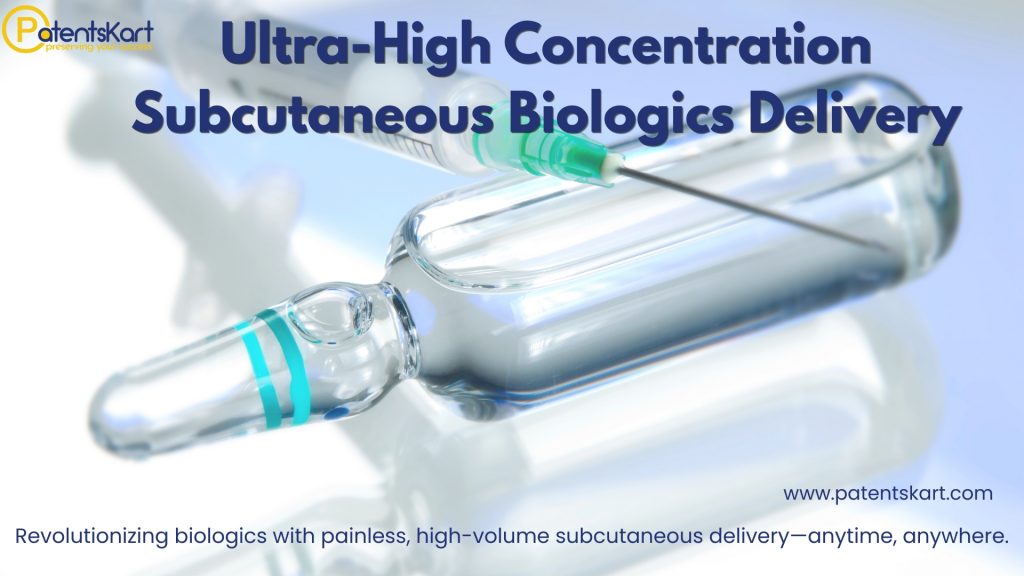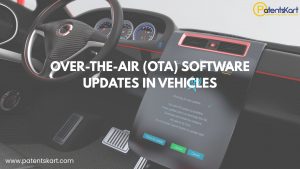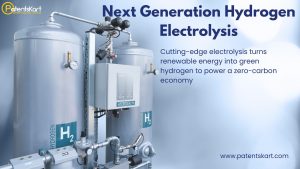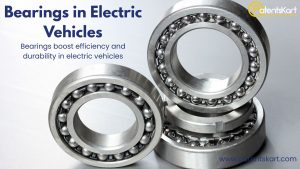The pharmaceutical industry is entering a new era where innovation in biologics meets patient-centered care. Traditional biologic drugs, particularly monoclonal antibodies and other large molecules, often require intravenous infusions in hospital settings. While effective, these methods are time-consuming, costly, and inconvenient for patients. Enter ultra-high concentration subcutaneous biologics delivery—a technology that allows powerful biologics to be administered in small volumes under the skin.
By shifting treatments from infusion centers to at-home settings, ultra-high concentration subcutaneous biologics delivery enhances comfort, reduces healthcare burdens, and broadens access. Combined with advances in drug delivery technology, this approach is reshaping patient-centric therapies and setting the stage for a new generation of pharmaceutical innovation.
What Is Ultra-High Concentration Subcutaneous Biologics Delivery?
At its core, ultra-high concentration subcutaneous biologics delivery is a formulation and device innovation that allows biologics—especially monoclonal antibodies—to be concentrated into smaller injection volumes without losing stability. These formulations are then delivered through advanced biologics injection systems that minimize discomfort and maximize efficacy.
Key elements include:
- Formulation science: Stabilizing proteins at higher concentrations.
- Device engineering: Injection systems designed to handle viscous solutions.
- Patient focus: Self-administration at home for greater convenience.
This shift enables a fundamental redesign of how complex therapies are delivered to patients.
Why Is Ultra-High Concentration Subcutaneous Biologics Delivery Important?
The importance of this technology lies in addressing three major industry challenges:
- Rising demand for biologics: As monoclonal antibodies and other advanced therapies dominate pipelines, delivery methods must evolve.
- Patient-centric therapies: Moving away from hospital-based infusions empowers patients and reduces treatment fatigue.
- Healthcare cost control: By reducing infusion-related infrastructure, providers lower total care costs.
Ultra-high concentration subcutaneous biologics delivery represents a step toward a more sustainable, efficient healthcare ecosystem.
How Does Ultra-High Concentration Subcutaneous Biologics Delivery Work?
This approach integrates formulation and device advances into a seamless experience:
- Concentration: Biologics are concentrated up to several hundred mg/mL using stabilizers that prevent aggregation.
- Viscosity management: Specialized excipients and formulation techniques reduce injection force.
- Injection systems: Devices such as autoinjectors and on-body delivery systems administer doses comfortably.
- Absorption optimization: Pharmacokinetic modeling ensures drugs remain effective when injected subcutaneously.
By combining formulation expertise with biologics injection systems, ultra-high concentration subcutaneous biologics delivery allows treatments that were once intravenous to move into subcutaneous settings.
What Are the Key Benefits of Ultra-High Concentration Subcutaneous Biologics Delivery?
The benefits span clinical, economic, and patient-centric dimensions:
- Improved convenience: At-home self-injection reduces hospital visits.
- Smaller volumes: Patients receive high doses in just a few milliliters.
- Lower costs: Cuts infrastructure and staffing costs for healthcare systems.
- Patient satisfaction: Less treatment fatigue, better adherence.
- Broader access: Enables therapies in regions with limited infusion facilities.
For pharmaceutical companies, this also supports pharmaceutical innovation by creating differentiation and lifecycle management opportunities.
What Are the Applications and Use Cases?
Ultra-high concentration subcutaneous biologics delivery is being applied across multiple therapeutic areas:
- Oncology: Delivering monoclonal antibodies for cancer treatment.
- Immunology: Treatments for autoimmune diseases like rheumatoid arthritis.
- Rare diseases: High-dose enzyme replacement therapies.
- Vaccines: Development of concentrated formulations for global immunization.
- Chronic conditions: Long-term therapies that benefit from reduced dosing frequency.
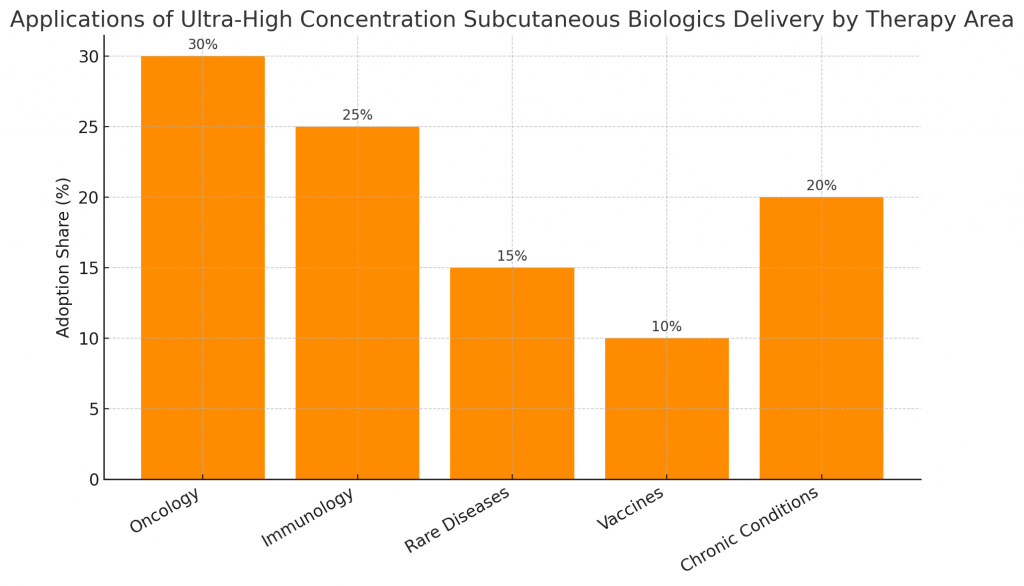
By enabling self-administration and reducing treatment times, this technology is central to the growth of patient-centric therapies.
Which Companies Are Leading in This Field?
Several pharmaceutical leaders are driving adoption:
- Roche/Genentech: Developed subcutaneous versions of blockbuster monoclonal antibodies.
- Amgen: Focused on biologics injection systems with next-generation devices.
- Pfizer: Exploring high-concentration biologics for oncology and immunology.
- Novartis: Investing in drug delivery technology for rare diseases.
- Sanofi: Partnering with device manufacturers for combination products.
These companies highlight how ultra-high concentration subcutaneous biologics delivery is becoming a core part of strategic pipelines.
Which Startups Are Innovating in Drug Delivery?
- Halozyme Therapeutics: Pioneered recombinant hyaluronidase to enable high-volume subcutaneous injections.
- Enable Injections: Developing wearable on-body delivery systems.
- Portal Instruments: Needle-free biologics delivery platforms.
- MedinCell: Formulation experts for long-acting injectables.
- Stevanato Group: Advanced autoinjector systems tailored for viscous biologics.
These startups are redefining drug delivery technology and making ultra-high concentration subcutaneous biologics delivery more accessible.
What Do Patents and TRL Insights Reveal?
Patent activity is clustered around:
- Stabilizers and excipients for concentrated formulations.
- Injection device designs for viscous solutions.
- Wearable delivery systems for sustained release.
- Analytical methods for biologics stability.
Technology Readiness Levels (TRLs) suggest:
- Established formulations: TRL 8–9, in commercial use.
- Wearable devices: TRL 6–8, entering pilot deployments.
- Needle-free systems: TRL 5–7, experimental but promising.
- Next-gen excipients: TRL 4–6, still under development.
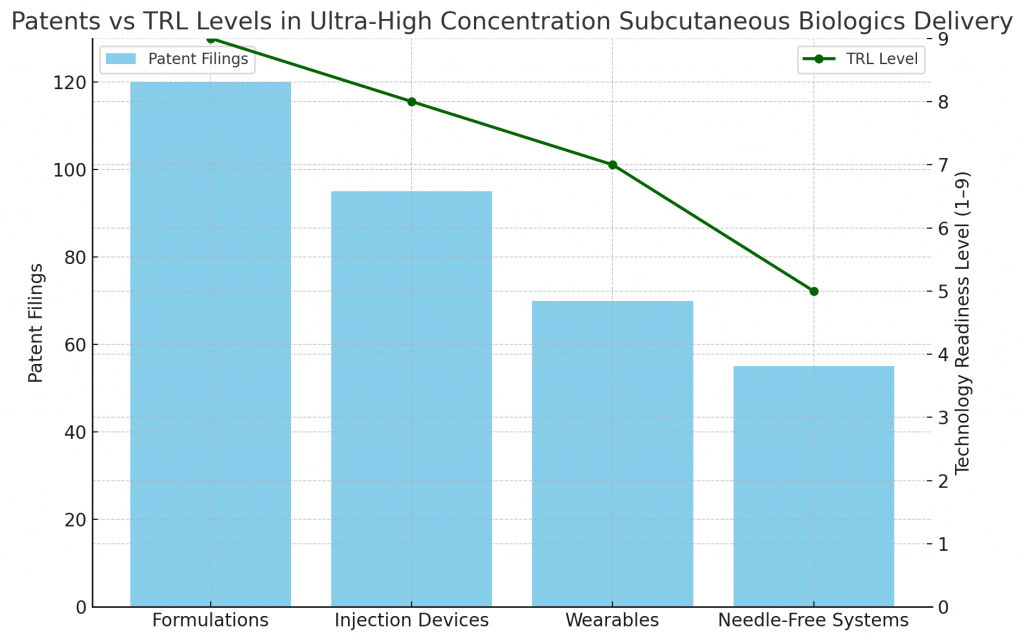
This landscape reflects both maturity and innovation potential.
What Are the Key Challenges?
Despite its advantages, the technology faces hurdles:
- Viscosity limits: High concentration increases injection difficulty.
- Device complexity: Need for robust biologics injection systems.
- Formulation stability: Proteins risk aggregation at high concentrations.
- Regulatory hurdles: Combination products require dual approvals.
- Patient adoption: Ensuring confidence in self-administration.
Addressing these barriers is essential for scaling ultra-high concentration subcutaneous biologics delivery.
What Is the Future Outlook?
Looking forward, several trends stand out:
- Next-gen autoinjectors: Devices designed for high-viscosity biologics.
- Digital integration: Smart injectors that track adherence.
- Expanded access: Wider adoption in emerging markets.
- Sustainable bioprocessing: Eco-friendly device materials and formulations.
- Lifecycle management: Reformulation of existing biologics to extend product life.
With these trends, ultra-high concentration subcutaneous biologics delivery will remain central to pharmaceutical innovation.
How Can PatentsKart Help?
PatentsKart provides vital support for companies pursuing ultra-high concentration subcutaneous biologics delivery:
- Patent landscaping to identify gaps and opportunities.
- Freedom-to-operate analysis to mitigate litigation risks.
- Competitor monitoring to track emerging players.
- TRL benchmarking to align R&D with readiness.
- Partnership scouting to accelerate commercialization.
By leveraging our expertise, organizations can innovate confidently in biologics delivery.
Conclusion
Healthcare is moving toward personalization, accessibility, and sustainability. Ultra-high concentration subcutaneous biologics delivery embodies all three goals. By enabling at-home care, reducing costs, and supporting patient empowerment, this technology reshapes the relationship between patients, providers, and pharmaceutical companies.
Those who invest early in ultra-high concentration subcutaneous biologics delivery will not only meet market demands but also lead in building the future of patient-centric therapies.
FAQs About Ultra-High Concentration Subcutaneous Biologics Delivery
Q1. What is ultra-high concentration subcutaneous biologics delivery?
It is a method that allows biologics to be delivered in small injection volumes under the skin, reducing the need for infusions.
Q2. Why is it important for patients?
It enables at-home self-injection, reducing hospital visits and improving convenience.
Q3. Which companies are leading in this field?
Roche, Amgen, Pfizer, Novartis, and Sanofi are among the leaders.
Q4. What challenges limit adoption?
Viscosity, device design, stability, and regulatory hurdles are the main obstacles.
Q5. How does PatentsKart help innovators?
By providing patent insights, competitor tracking, and TRL benchmarking to guide innovation.

